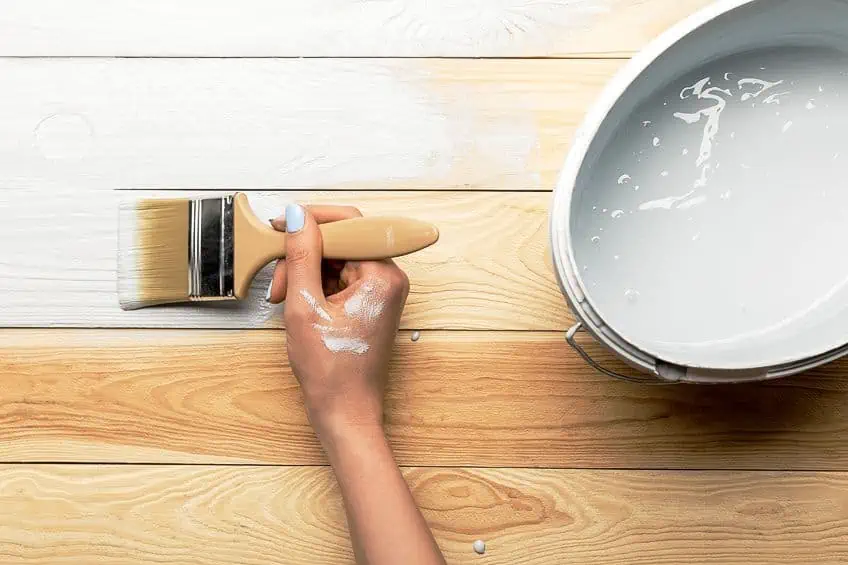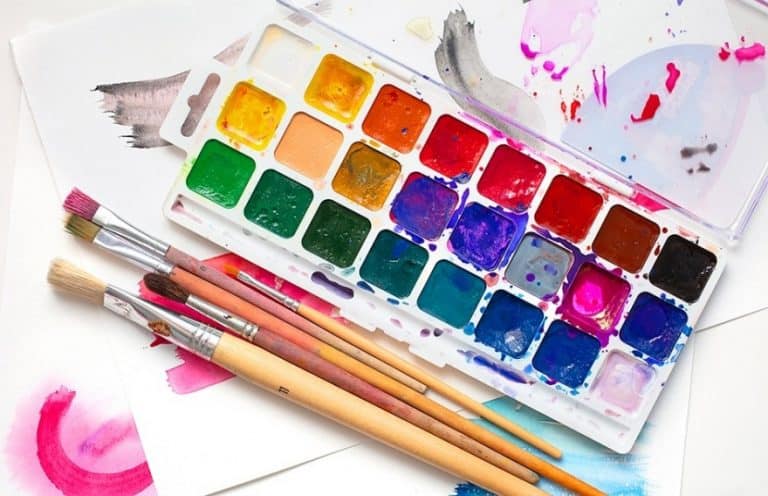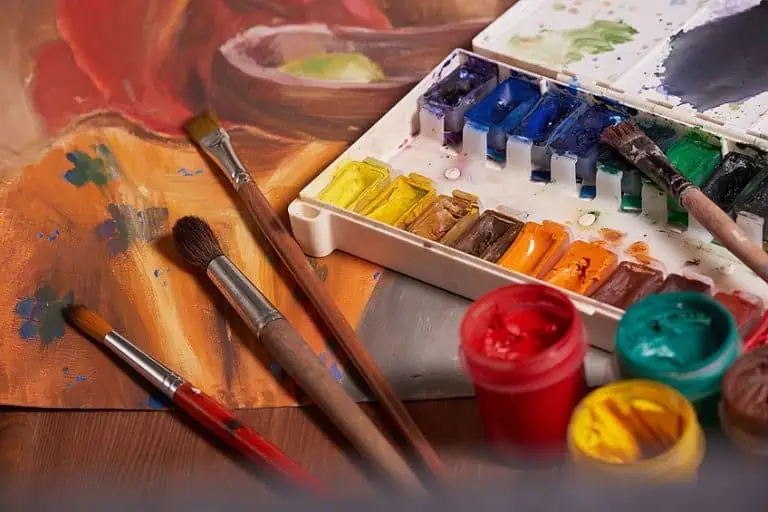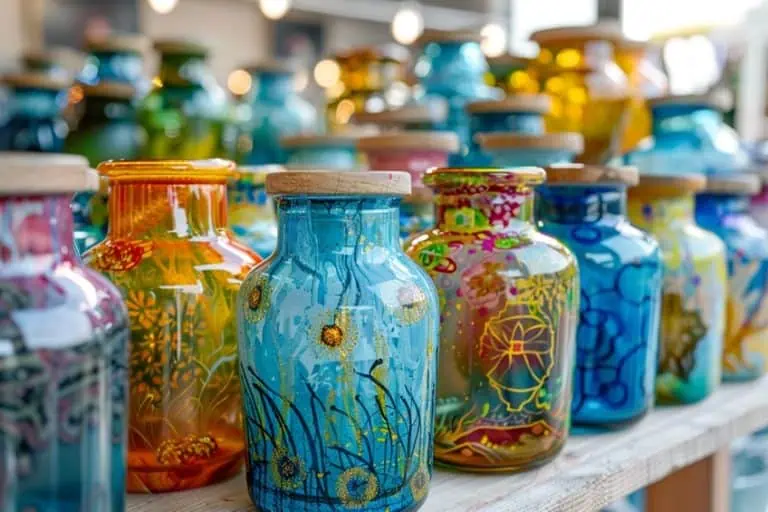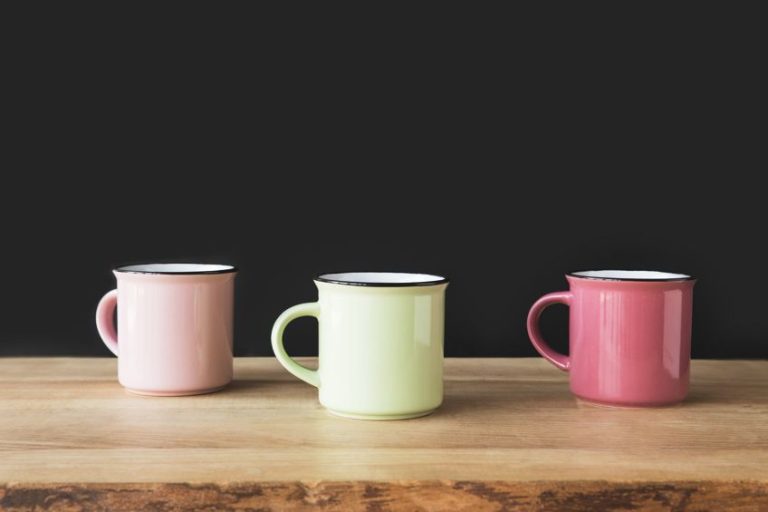Painting Surfaces for Acrylics – Prepare Surfaces Before You Paint
This post may contain affiliate links. We may earn a small commission from purchases made through them, at no additional cost to you.
Acrylic paints are a popular and versatile medium that is perfect for beginners and professional painters alike. Its versatility allows it to be used on a large array of surfaces, each with different benefits and challenges. The painting surface you choose is important as it can affect the ease, look, and longevity of your paintings. Below, we explore some of the most popular painting surfaces for acrylics, as well as how to prepare them for the best results.
Table of Contents
Why Is Your Painting Surface Important?
You may be wondering why you should care about painting surfaces for acrylics. Although acrylic paints have amazing versatility the painting surface has a large impact on the longevity of your paint as well as how easily it applies. Smooth, non-porous, or unprepared surfaces are the most difficult to paint, while rough, porous, and properly prepared surfaces are ideal for painting with acrylic paints. Painting surfaces for acrylic paint are sometimes referred to as a painting substrate or support but can include any number of things you can paint on.
Popular acrylic painting surfaces include paper, canvas, wood, hardboard panels, and fiberboard. Each of these surfaces has its own pros and cons and can be prepared in different ways for better results.
Paper
Paper is often the first painting surface that many acrylic painters use. Paper is a great painting surface for acrylic paints and higher quality papers can even be very durable. There are many varieties of paper available for artists to use, with some being specially formulated to be used with acrylic paints. Acrylic paper is a heavyweight paper, which allows it to withstand the moisture in acrylic paints. It comes in sheets or pads and is available in a variety of colors and textures for all types of acrylic painting techniques.
You can apply paint directly onto the paper; however, it can be beneficial to prime the front and back of the page with gesso before painting.
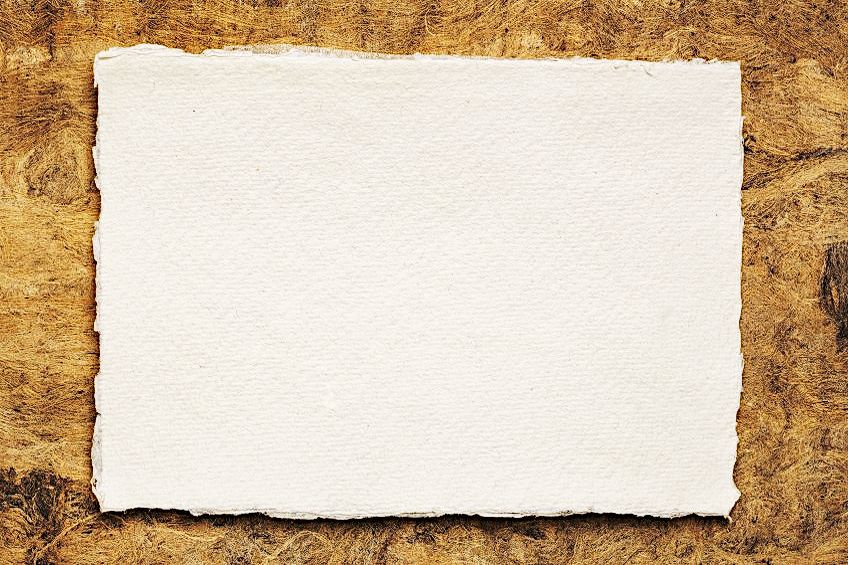
This acts to reinforce the paper, making it more durable, and improves paint adhesion and absorption. Acrylic paper is the most budget-friendly option of all traditional acrylic painting surfaces and is also widely available and highly portable. This makes it perfect for beginners or those that like to paint outside the studio. Even though acrylic paper is more resistant to warping and tearing than regular paper, using a lot of water or thick layers can still affect it. It is important to experiment with different papers and techniques to find one that works best for you.
Watercolor Paper
Aside from acrylic paper, watercolor paper is also a popular option for many acrylic artists. This type of paper is specially formulated to be used with large amounts of water and so is more resistant to warping and tearing when using wet acrylic paint techniques. Watercolor paper comes in a range of sizes, grades, and textures and is typically sold in individual sheets, large rolls, or spiral-bound pads. Watercolor paper can be used with or without priming with gesso, but you may need to stretch and tape down the paper if you plan to use lots of water to avoid wrinkling.
You could also use watercolor panels or blocks, which are stacks of paper glued along the edges. Once you have finished painting the top sheet, you can cut it from the pile and continue painting on the sheet underneath.
Other Paper Options for Acrylic Paint
Using novel paper is another great way to experiment with acrylic paints and give your paintings a unique look and feel. Instead of using plain white paper, starting on colored paper can give your paintings a specific tone without having to underpaint it. Just remember to use a clear gesso over colored paper if you are going to prime it so that the color shows through. Other paper types such as Nepalese, Japanese, Thai, Bhutanese, Indian, bark, and amate papers are also great for experimenting with and create interesting effects within your work.
Canvas
Canvas has long been considered the traditional surface for painting from the great painters of old to modern artists. The canvas is arguably the most common painting surface for acrylic artists and there are a variety to choose from to suit your artistic needs. The reason for its popularity can be attributed to the ease with which paints can be applied to its surface as well as its durability and longevity. Many oil paintings on canvas have lasted for centuries and some of the first acrylic paintings created when the painting medium was developed in 1934 can still be viewed today. Canvas is not only durable but lightweight as well, which enables artists to create large pieces that have great structural integrity and are only a fraction of the weight of other painting surfaces. This also makes them easy to transport, allowing artists to paint wherever they are without the fear of their paintings being torn. Unfortunately, all these benefits mean that good quality canvas can be very expensive, especially the larger ones.
Canvas is most commonly manufactured from natural fibers like linen or cotton that can be stretched over a frame.
Canvas can also be produced by gluing these fibers to a panel. Linen canvas is generally more expensive than a cotton one, but is more durable, less flexible, and has a rougher surface than cotton canvas. Linen canvases generally last much longer than cotton ones, although cotton duck canvases of a high-quality do have a lot of durability as well. Cotton canvas is best suited to small to medium paintings as its flexibility could cause dips in the middle of large paintings where the material is not taut enough, creating an uneven painting surface. Canvases are produced in various textures and weights depending on the materials and weave used to create them.
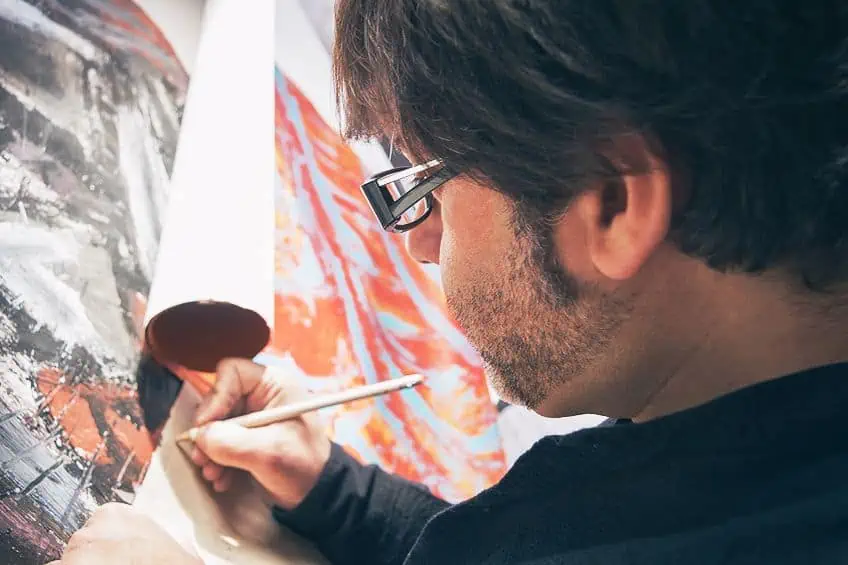
The texture of your canvas depends on its weave, with a finer weave producing a smoother canvas, although they are generally more expensive. Rougher canvases are more suited to bolder brushstrokes and large works while smoother canvases are preferred by artists who have smaller and more detailed works. The weight of your canvas depends on its thread density, which is measured in ounces per yard. Higher weights indicate a higher quality canvas as more thread was used to make it. Canvases lighter than eight to ten ounces should be avoided as they are generally of subpar quality.
There are four main varieties of canvas that are used as acrylic painting surfaces, each of which are widely available. These include canvas rolls, stretched canvas, canvas pads, and canvas panels.
Canvas Rolls
A canvas roll is simply canvas that has not been stretched over stretcher bars. The material can be primed with gesso to build a surface that is more receptive to painting. You can also use acrylic paints on unprimed canvases; however, the colors will be duller compared to painting on a primed canvas, and the canvas texture will be much more prominent. Preparing your painting surface by priming it is important to make your acrylic paints apply evenly and last longer.
Whole rolls can be expensive to buy, however, they are cheaper when you stretch your own canvases. You do not have to stretch them though; many artists make use of the flat canvas as is.
Stretched Canvas
Stretched canvas is usually what you picture when talking about canvas. As the name implies, these are made by stretching canvas material around a wooden frame, which are also called stretcher bars. Like with canvas rolls, they come in both primed and unprimed varieties and in various weights and textures. You can stretch and prime the canvas yourself if you are interested in learning the process, or you want to create a uniquely shaped canvas. You can also buy them pre-stretched and primed, which is more convenient and beginner friendly.
Coating your canvas in one or two layers of gesso is a good practice, even for pre-primed canvases as it aids in absorbency. Be sure to check that your canvas is primed for acrylic paints and not oil paints, although some can be primed for both.

Stretched canvases come in both deep and traditional thicknesses, which can affect how you choose to display your final piece. Traditional canvases are made with thinner stretcher bars, usually less than an inch thick, while deep canvases are made with thick stretcher bars, which can be more than three inches thick. If you plan to leave your painting unframed, a deep canvas may work better for you as it allows the painting to stand out from the wall and enables you to paint the sides and edges of the painting, giving your painting a three-dimensional look. If you wish to frame your work, traditional canvases will work better for you.
Canvas Pads
Canvas pads are made of sheets of primed canvas or canvas paper, which have been spiral bound together. These pads are perfect for beginners as they allow them to practice with acrylic paint on canvas material without using expensive stretched canvas or rolls. Pads can contain either canvas sheets or canvas paper, which is a heavyweight paper with a similar surface texture to canvas sheets. Pads with canvas sheets can last many years and can be stretched and mounted, however, they do not have the same longevity as a traditional stretch canvas.
Canvas pads are more cost-effective than canvas rolls and more lightweight and portable than stretched canvas. They also come pre-primed and require no set-up, making them perfect for artists who like to paint on the go.
Canvas Panels
Canvas panels are great for those looking for a durable acrylic painting surface that is cheaper than stretched canvas. Canvas panels are made by mounting the canvas material onto a stiff backing board. These panels come in a variety of colors and textures and are more durable than canvas pads or rolls. Canvas panels are easier to frame than stretched canvas as they are thinner. They are also lighter and more compact than stretched canvas, which makes them perfect for beginners and students.
Canvas panels are not permanent, however, and will slowly degrade, becoming warped and brittle especially if they are made from cheaper materials.

Wood
Hardwood panels are more popular painting surfaces for oils and tempera paints; however, some acrylic artists still make use of this painting surface. These panels are usually made from hardwoods such as birch, oak, walnut, maple, and mahogany. Softwoods are not as common as they are prone to warping, particularly with the moisture from acrylic paints, however, some can be used if they are prepared properly. Well-seasoned wooden panels are very resistant to warping and splitting, however, they are also very heavy and expensive compared to other painting surfaces. They can be awkward to carry around and take with you so are not recommended for plein air painting.
This durability does make them extremely long-lasting, however, and great for painting techniques that use thick layers of paint or require more support.
It is recommended to use sealed wood panels and prime the surface with a gesso before painting. This is because wood contains many impurities, which can leak into your paints and cause yellowing. This is especially important for wood that has been repurposed from other pieces such as old furniture. Wood is also highly absorbent, so unsealed wood will absorb large amounts of paint. This will cause your paint to dry much faster and result in you using much more paint than you normally would.

To prepare wood for painting, always ensure that its surface is clean and dry before sealing it and then priming it. Paint will apply smoothly onto a primed wood surface and spread much further than on canvas or paper. You can try priming your wood with a clear gesso to allow the grain of your wood to show through and give your painting a unique effect.
Hardboard Panels
More commonly known as Masonite, hardboard panels are a mixture of wood fibers that have been molded into flat composite panels using pressure, heat, and natural adhesion. This process gives these panels the feeling of natural wood, but with a smoother surface without the wood grain. Hardboard panels also contain fewer impurities than natural wood, making them less likely to stain or yellow your acrylic paints. These panels come in tempered and untempered varieties, and if you are looking to use Masonite boards for acrylic painting, it is important to only use untempered boards.
Tempered panels are flooded with linseed oil after hot pressing. Not only do the water-based acrylic paints not sit well on top of the oil, but this process also makes the panel’s surface non-porous and smoother, which is difficult for acrylic paints to adhere to.
Masonite boards come in a variety of colors and have a smooth front surface with a rough back surface. Most artists use the front surface after lightly sanding it to make the paint adhere better, however, artists use the back surface as well. Unlike wood, hardboard panels do not need to be primed, but applying a thin layer of gesso before painting can improve the longevity and vibrancy of your painting. Hardboard panels are an excellent choice for beginners who are interested in exploring painting surfaces other than canvas, as they are generally inexpensive and highly durable. This painting surface is best suited for small to medium paintings as very large panels are prone to warping and bending after some time.

This can be somewhat combated by priming your board or reinforcing the underside of the board. Particleboard is another composite panel that is made from pressured sawdust in place of larger wood fibers. These are a cheaper option for a painting surface that works similar to hardboard panels. The main difference between particleboard and hardboard is the tendency for particleboard to swell from the moisture of the paint. To avoid this, several coats of sealer and primer should be applied to protect the panel, which can then be sanded smooth to create an even painting surface.
High and Medium Density Fiberboard
Another type of composite that can be used as painting surfaces for acrylic are fiberboards. There are two varieties that can be used for acrylic painting, high-density and medium-density. Medium-density fiberboard (MDF) is the most regularly used of the two and is similar to hardboard paneling. The difference between the two lies in how they are made. MDF is also made using pressure and heat but uses wax or resin as a binding agent as well. This makes MDF more durable and less dense than hardboard panels, but also slightly thicker.
These boards provide a smooth painting surface, are widely available, and affordable, which is why it is very popular with students looking for a cheap permanent painting substrate.

Caution should be taken when cutting these fiberboards, as the formaldehyde from the resin used in some boards are carcinogenic and are released into the air when the boards are cut. Use a respirator when cutting these boards and be sure to prime all sides to minimize any risk. Priming will also create a better surface texture and absorbency for your acrylic paints, as unprimed MDF is not water-resistant, and your paints will soak into its surface.
Other Surfaces for Acrylic Paint
There are many other things you can paint on aside from traditional painting surfaces. While some of these surfaces can require some additional preparation to ensure your paint adheres properly, they are an excellent way to experiment with your acrylic paints.
Cardboard
Using cardboard for acrylic paint is very similar to using paper. Both surfaces are highly absorbent, and both are budget-friendly and widely available. Cardboard tends to be more durable than paper meaning you can apply more water or layers to its surface before it starts to disintegrate. Be sure to use acid-free cardboard without inks as these are least likely to have impurities that could leak into your painting and stain your work.
You can also prime the surface with gesso to prevent this and reinforce it for wetter techniques.
Fabric
Fabric is a great painting surface for acrylics as it is textured and absorbent. Most fabrics work similar to canvas and can even be glued to wooden boards or onto a stretch canvas. You can paint a variety of fabrics including silk, denim, leather, and cotton, to name a few. When painting on lighter fabrics such as satin or silk, using fluid acrylics or adding a fluid medium to your paints will ensure the fabric does not become stiff once dry.
Painting on a patterned fabric is a fun way to get inspired by the colors and shapes that are already there, especially if a blank canvas feels too daunting.
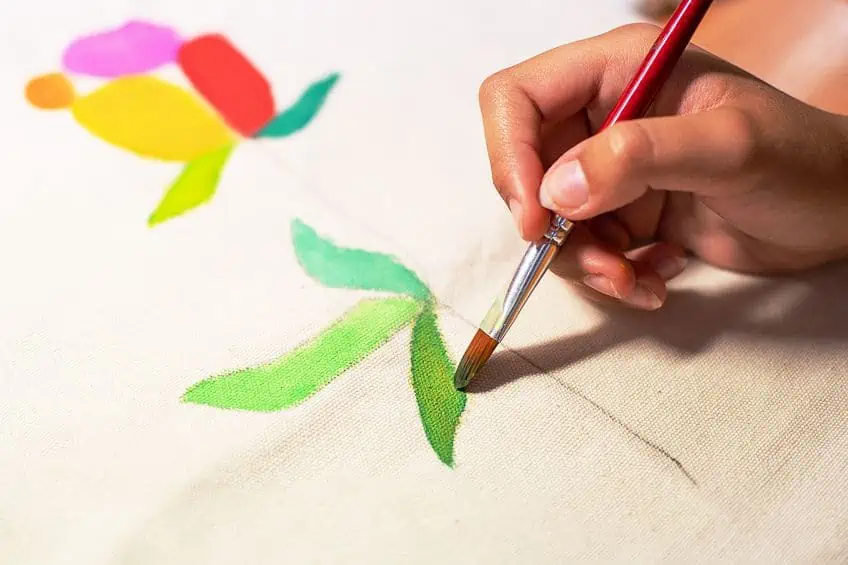
Acrylic paints are largely permanent on most fabrics once dry, although they can fade slightly after washing. Add a fabric medium to your acrylic paints to make them last longer and more resistant to fading. Wash your fabric with warm water and soap, then soak it in vinegar for a few minutes, rinse, and dry. This ensures that your fabric is clean and dry, without any residue from fabric softeners, and creates a better surface for your paint to adhere to.
Metal
Acrylic paints can also be used on metals if the proper precautions and preparations are taken. The two main issues for painting on metal are rust and paint adhesion. Metals that are resistant to rust such as steel and other ferrous metals are better for acrylic painting. Priming the surface of the metal will help the paint adhere better and applying a sealant over the works will protect the paint and prevent it from peeling.
Be sure to clean the metal’s surface with soap and water, followed by rubbing alcohol to ensure all residual dirt and oils are removed.
Glass
Like with metal, acrylic paints have a difficult time adhering to glass due to its glossy and non-porous surface. To protect the paint from peeling off once it has dried, the glass surface can either be primed with gesso or made rougher using sandblasting or etching. Sandblasting and etching can make glass slightly cloudy, so clear gesso can be used if you prefer to maintain the transparency. Before painting your glass, clean the surface using warm water and soap, dry, and then wipe with rubbing alcohol to remove any residual soap, dirt, and oil. Be sure to wear gloves when handling the glass after cleaning to prevent oils from your hands transferring to the glass.
After painting, use a sealant to protect the paint and further prevent it from flaking and peeling.

Plastic
Like glass, plastic is largely non-porous so can be difficult to paint with acrylics. Unlike glass, hard plastic can be lightly sanded to produce a rough surface that is better for the glass to adhere to and give your paints more longevity. Your works can also be sealed to protect it even more from peeling or flaking off. Be sure to prepare your plastic properly before painting by cleaning it with soapy water and wipe it down with rubbing alcohol to remove any excess dirt and oils for the best results.
You can also prime the surface of the plastic with gesso to make your paints adhere better.
Stoneware, Terracotta, and Porcelain
Stoneware comes in many varieties but can be broadly divided into glazed and unglazed stoneware. Unglazed stoneware is porous so great for painting with acrylics; however, it needs to be sealed both inside and outside if it is going to contain any moisture. This is to protect the paint from dissolving as the water passes through the stoneware. If you are painting on mugs or plates, avoid painting sections that will come in direct contact with food as acrylic paints are non-toxic but not considered food safe.

The versatility of acrylic paint gives you lots of freedom to be creative. If you are wondering what to paint on besides canvas, you can consider any of these other painting surfaces for acrylics. Each comes with its own pros and cons, so do some research to see which one is right for you.
Frequently Asked Questions
What to Paint on With Acrylic Paint?
Acrylic paints can be used to paint on many surfaces including paper, canvas, fabric, wood, hardboard panels, fiberboard, cardboard, and unglazed stoneware. Acrylic paint easily applies and adheres to these surfaces and can last for many years.
How to Prepare a Surface for Acrylic Paint?
The surface you wish to paint will have a big impact on the best way to prepare it for acrylic painting. Textured and porous surfaces do not need much preparation other than being clean and dry, however, a layer of gesso can be applied before painting to prime it. Priming the surface will increase the durability and vibrancy of your acrylic paints. For smooth and non-porous surfaces, they will need to be roughened by sanding or etching and primed to create a surface that acrylic paint can adhere to. Organic surfaces such as wood should also be sealed to prevent impurities from staining or yellowing your paint.
What Are the Worst Surfaces for Acrylic Paint?
Acrylic paint works best on surfaces that are textured, porous, and free from debris. Surfaces such as glass, metal, and hard plastics have smooth and non-porous surfaces, which makes it hard for acrylic paint to adhere to. Even if you prepare the surfaces well, acrylic paint is not permanent on these surfaces and will eventually rub or peel off.
Megan is a writer and researcher who graduated from the University of Cape Town with a degree in Social Sciences, specializing in Psychology and Environmental Science. Her passion for knowledge and leaving a positive impact has fueled her current work in conscious and sustainable growth in Southern Africa. Megan’s love of nature has also led her to train as an animal behaviorist. She works part-time training and rehabilitating dogs. Megan is interested in the physical and psychological effects of colors in our environment on our mood and well-being. In addition, she is concerned with how art and creativity have been an integral part of human society. Megan van Schoor has been writing blog posts on the topics of painting, drawing, and color theory for acrylgiessen since 2021.
Learn more about Megan van Schoor and about us.
